Back to Contents

Read Standard
Panel Conclusion 2018
Milestones Completed
The MBA Programme has been strategically designed to feature a business-oriented curriculum with a focus on service excellence. The intake process focuses on matching the students to the programme and its objectives. Since the start this design has attracted a diverse range of candidates, varying in educational background, work- and life experience, age, cultural background and of course personality and skill set. The graphs below show the extent to which the MBA succeeds in doing so on some of the variables mentioned.
Intake year
Percentage per Industry
Percentage per Industry
Student Intake and Educational background
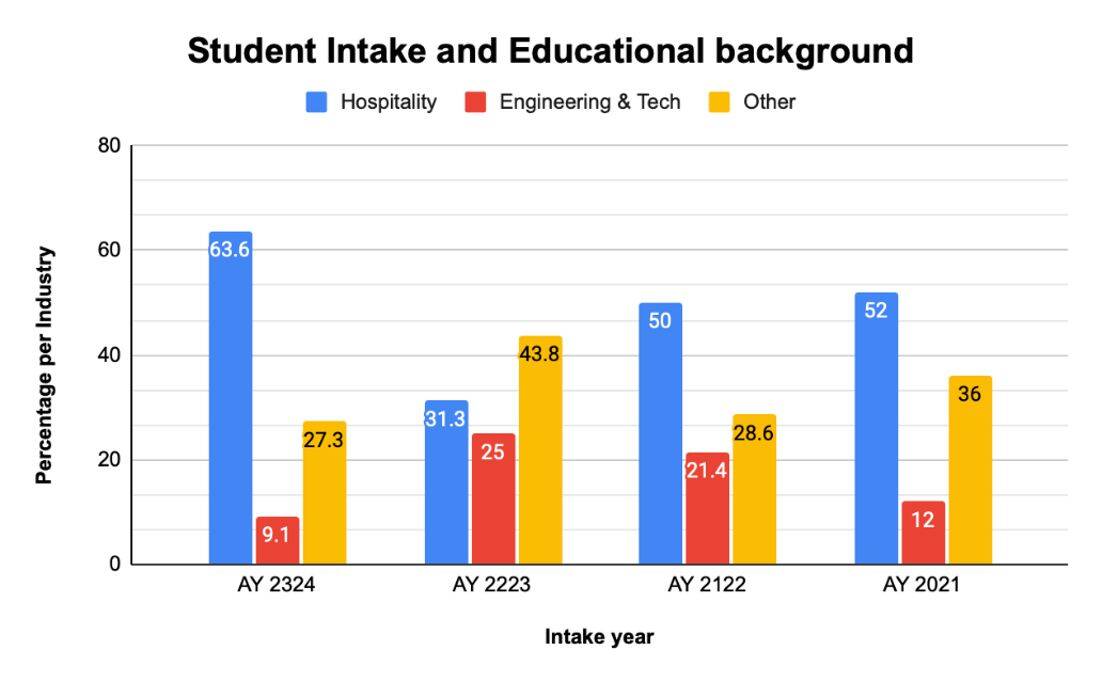
Intake year
Number of Students
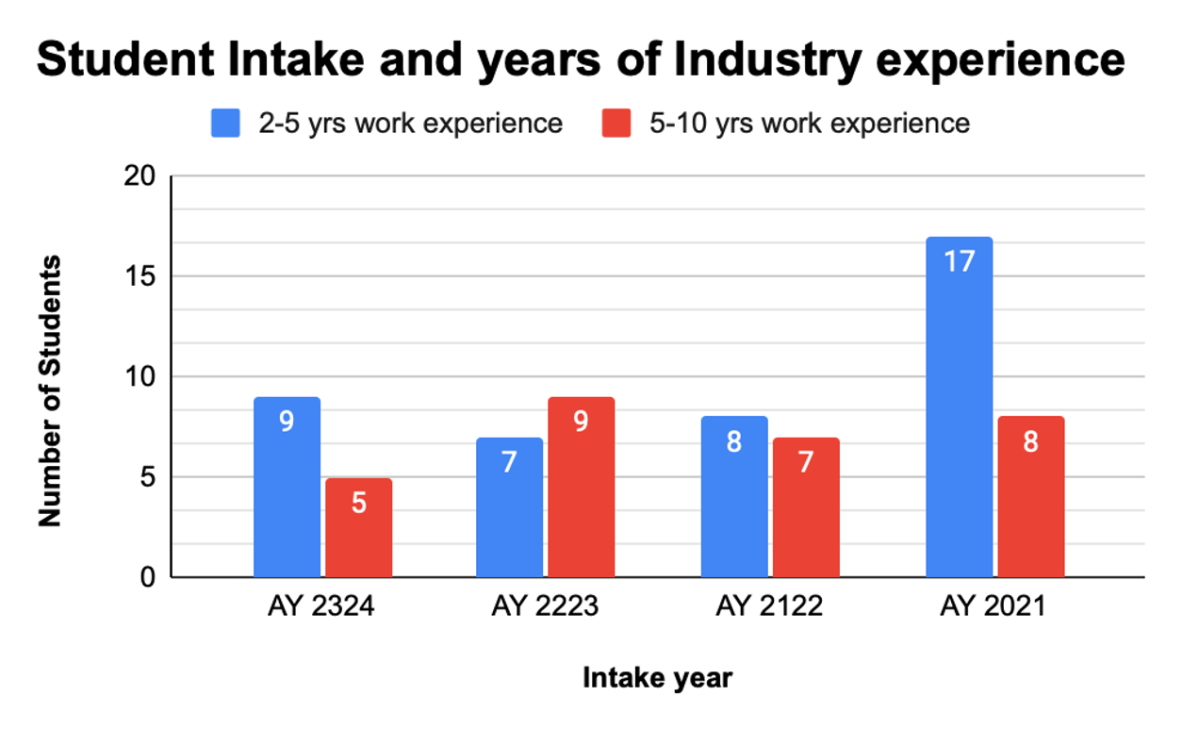
Student Intake and years of Industry experience
Intake year
Number of Students
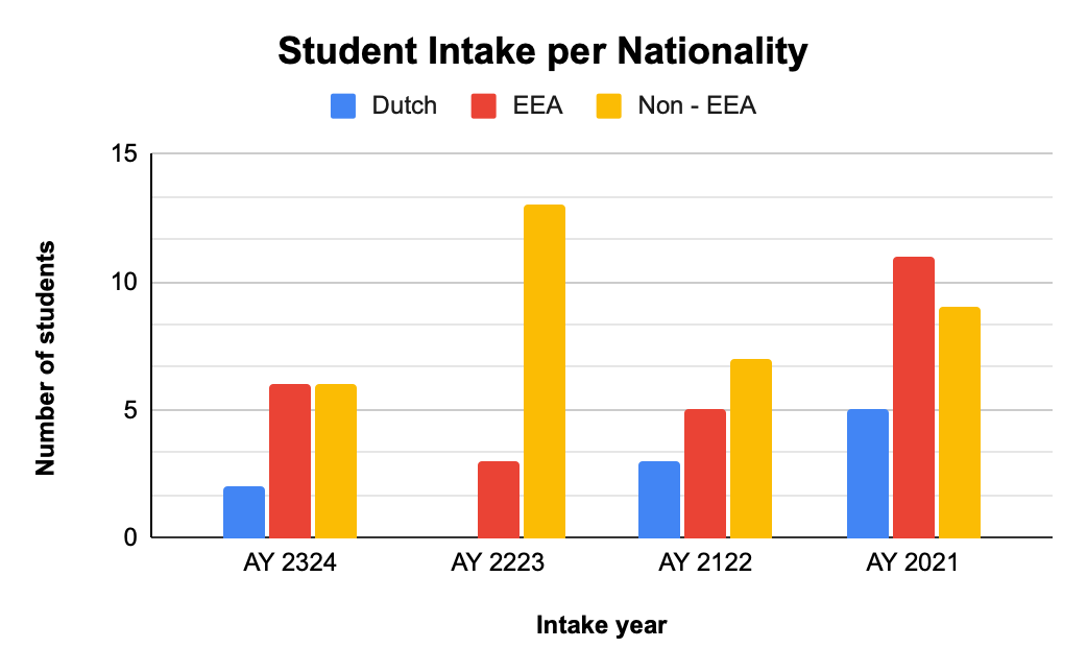
Student Intake per Nationality
The alumni reflect on the importance of a diverse groups as follows:
“The diversity in the group was one of the assets of our year in the MBA. It forced me to keep an open mind and exactly that taught me that some of the biggest career lessons were in the learning from other perspectives and not in the books.”
Atif Sherwani, 2023
“The first weeks were a marvellous clash. All new people, all different cultures. This diversity struck me more than the fact that Amsterdam has running water everywhere and that you can drink from the tab at home.” Isabella Gonzalez, 2023
The selection process currently consists of the following elements:
Informal consult & review of academic and professional background
Instruction to write the essay, motivation letter and submit an example of academic research done (most often a thesis or graduation project)
Alumni consult
Formal consult, final Q&A and review
Final interview with Programme Director and Programme Coordinator
The focus of the selection process lies on finding those candidates that do not just apply to any given university because of its reputation, ranking or professional network, but who take the time to research what they are going to learn, and determine why it’s the best choice for their professional growth.
Further, the application requirements, selection process and appeal guidelines are stated in the overall HTH Application and Selection Regulations, in which chapter 4, 5 and 7 refer to the MBA processes.
Candidates understand that they are on the verge of making an investment in time, energy, money and opportunity, and are aware of what they get in return. The ’check for motivation’ revolves around bringing out more information on the candidates’ professional maturity, career aspirations, understanding of the MBA curriculum and the ability to demonstrate a clear link between the MBA curriculum and those career aspirations.
Application Specifics | |||
Total nr of applicants | Total nr of students | Conversion rate | |
AY 2324 | 184 | 14 | 1/13 |
AY 2223 | 189 | 16 | 1/12 |
AY 2122 | 273 | 15 | 1/18 |
AY 2021 | 528 | 25 | 1/21 |
Depending on when in time the candidates apply there is ample time for them to complete each step in the process, which is also encouraged. Programme management considers it vital for students to spend time on letting information ‘sink in’ and to discuss it with friends and family. After all, most of our students are from outside The Netherlands, starting the MBA encompasses so much more than enrolment into a full-time study programme. For that reason, the selector always tries to have the informal conversation about the circumstances in which the prospective student will take on the new academic adventure and tend to any concerns they might have.
When looking at the conversion rate ‘applicant-to-enrolled-student', it is clear the MBA receives interest from a large number of candidates. As described, the combination of informal and formal elements in the application and selection process invites candidates that meet the requirements to investigate our programme further and engage in the selection procedure. When the selector and the candidate discover together that the MBA is not the best fit, the coordinator is usually able to refer the candidates onwards to a different programme. More than once the MBA team has stayed in touch with these ‘rejected’ candidates, even resulting in for example a former candidate joining as a guest lecturer for the other master programme of the school. Overall, this process is characterised by a very favourable conversion rate, resulting in a best fit between students and programme, as illustrated in the following table:

Back to top
Back to Contents

The MBA Programme has been strategically designed to feature a business-oriented curriculum with a focus on service excellence. The intake process focuses on matching the students to the programme and its objectives. Since the start this design has attracted a diverse range of candidates, varying in educational background, work- and life experience, age, cultural background and of course personality and skill set. The graphs below show the extent to which the MBA succeeds in doing so on some of the variables mentioned.
Milestones Completed
Intake year
Percentage per Industry
Student Intake and Educational background
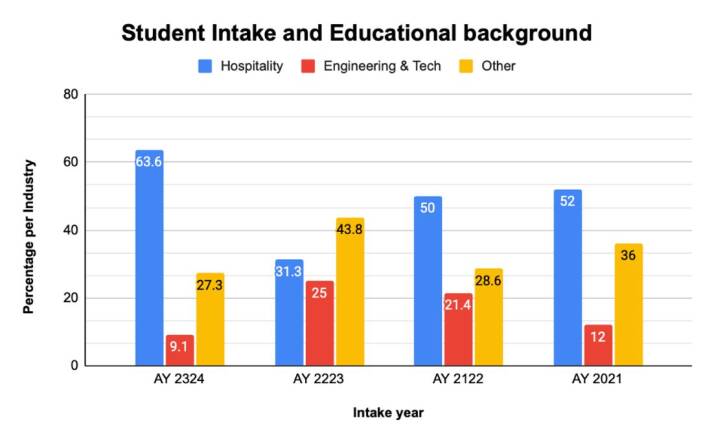
Intake year
Number of Students
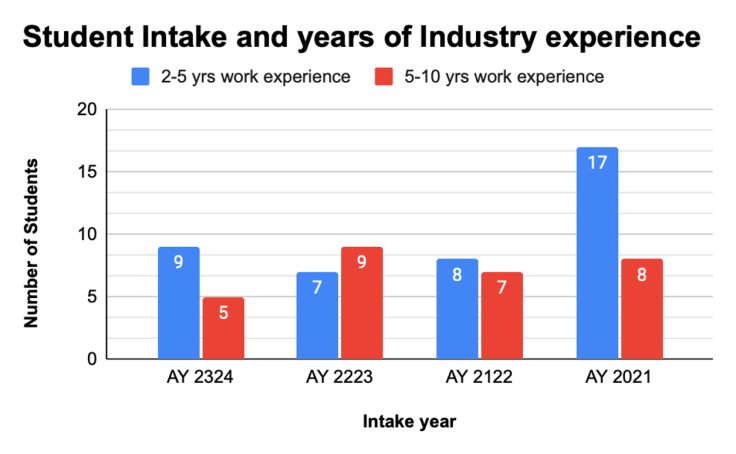
Student Intake and years of Industry experience
Number of Students
Intake year
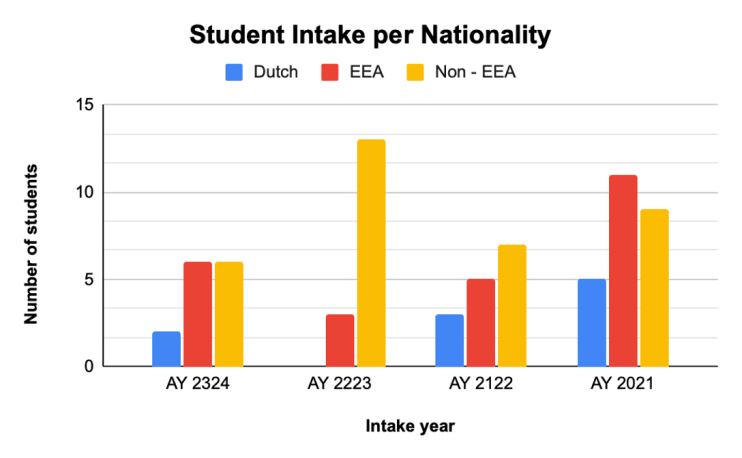
Student Intake per Nationality
“The diversity in the group was one of the assets of our year in the MBA. It forced me to keep an open mind and exactly that taught me that some of the biggest career lessons were in the learning from other perspectives and not in the books.”
Atif Sherwani, 2023
“The first weeks were a marvellous clash. All new people, all different cultures. This diversity struck me more than the fact that Amsterdam has running water everywhere and that you can drink from the tab at home.” Isabella Gonzalez, 2023
The alumni reflect on the importance of a diverse groups as follows:
The selection process currently consists of the following elements:
Informal consult & review of academic and professional background
Instruction to write the essay, motivation letter and submit an example of academic research done (most often a thesis or graduation project)
Alumni consult
Formal consult, final Q&A and review
Final interview with Programme Director and Programme Coordinator
The focus of the selection process lies on finding those candidates that do not just apply to any given university because of its reputation, ranking or professional network, but who take the time to research what they are going to learn, and determine why it’s the best choice for their professional growth.
Further, the application requirements, selection process and appeal guidelines are stated in the overall HTH Application and Selection Regulations, in which chapter 4, 5 and 7 refer to the MBA processes.
Candidates understand that they are on the verge of making an investment in time, energy, money and opportunity, and are aware of what they get in return. The ’check for motivation’ revolves around bringing out more information on the candidates’ professional maturity, career aspirations, understanding of the MBA curriculum and the ability to demonstrate a clear link between the MBA curriculum and those career aspirations.
Scroll
Application Specifics | |||
Total nr of applicants | Total nr of students | Conversion rate | |
AY 2324 | 184 | 14 | 1/13 |
AY 2223 | 189 | 16 | 1/12 |
AY 2122 | 273 | 15 | 1/18 |
AY 2021 | 528 | 25 | 1/21 |
Depending on when in time the candidates apply there is ample time for them to complete each step in the process, which is also encouraged. Programme management considers it vital for students to spend time on letting information ‘sink in’ and to discuss it with friends and family. After all, most of our students are from outside The Netherlands, starting the MBA encompasses so much more than enrolment into a full-time study programme. For that reason, the selector always tries to have the informal conversation about the circumstances in which the prospective student will take on the new academic adventure and tend to any concerns they might have.
When looking at the conversion rate ‘applicant-to-enrolled-student', it is clear the MBA receives interest from a large number of candidates. As described, the combination of informal and formal elements in the application and selection process invites candidates that meet the requirements to investigate our programme further and engage in the selection procedure. When the selector and the candidate discover together that the MBA is not the best fit, the coordinator is usually able to refer the candidates onwards to a different programme. More than once the MBA team has stayed in touch with these ‘rejected’ candidates, even resulting in for example a former candidate joining as a guest lecturer for the other master programme of the school. Overall, this process is characterised by a very favourable conversion rate, resulting in a best fit between students and programme, as illustrated in the following table:
Panel Conclusion 2018
Standard 5: Intake
The maximum intake for the master programme is 25. There is a solid application and selection procedure, based on personal contact, which enables HTH to assure the right fit and level of students in both programmes.

Back to top
